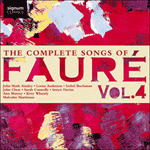This is one of the most autobiographical of all poems by Hugo, inexorable opponent of the corruptions of the ‘little’ Napoléon’s regime. From the collection entitled
Les châtiments, the poem was written at the beginning of the poet’s exile in the Channel Islands. Fauré sets these words eighteen years later in the wake of the Franco-Prussian war, the debacle which ended the emperor’s rule. Hugo’s opposition to Napoléon III had been vindicated by history, and in the grandeur of this music we feel that Fauré is somehow paying tribute to the great republican’s stand. It is typical of the composer, no revolutionary himself, that his tribute to Hugo’s bravery is a retrospective one; it is also typical of Hugo that instead of the prison and shroud he darkly predicts for himself in
L’absent, he will return to Paris, still alive and the most fêted Frenchman of all time. The swaying grass of the poem’s opening line inspires a bare accompaniment where minims toll like melancholy bells that mourn a living death. The vocal line, an elegiac pronouncement with the spoken immediacy of recitative, is supported by these rocking suspensions; despite restless harmonic movement the mood is one of emptiness. At ‘Chien, veille au logis’ (pets are dangerous participants in songs of this seriousness) the accompaniment quickens into triplets. The marking is
Un poco più mosso and it is the image of the child weeping for his absent father that releases the floodgates of emotion. That plaintive cry of ‘L’absent’, the highest note of the song, speaks for the pity of war and the panic of the displaced and dispossessed. In a wild outburst for piano Fauré abandons his customary restraint; this kind of interlude is scarcely to be found elsewhere in his songs. After these eight bars the return to the original tempo is perfectly engineered. The image of the ‘bagne sombre’ thickens the texture of the accompaniment: the minims now seem as impenetrable as prison walls, the vocal line fatally hesitant, the final left-hand triplets bathed in Stygian gloom.
from notes by Graham Johnson © 2005
Ce poème, l’un des plus autobiographiques de Hugo, inexorable opposant aux corruptions du régime de Napoléon «le Petit», est extrait du recueil intitulé
Les châtiments et fut écrit au début de l’exil du poète dans les îles Anglo-normandes. Fauré met ces mots en musique dix-huit ans plus tard, dans le sillage de la guerre franco-prussienne, la débâcle qui mit fin au règne de l’empereur. L’histoire avait avalisé l’opposition de Hugo à Napoléon III, et on sent bien que, par sa musique grandiose, Fauré entend saluer le choix du grand républicain. S’il est typique de voir Fauré, qui n’avait rien d’un révolutionnaire, rendre un hommage rétrospectif à la bravoure de Hugo, il est tout aussi typique de voir le même Hugo rentrer à Paris, bien vivant, en Français le plus fêté de tous les temps, loin de la prison et du linceul qu’il se promettait, sur un ton sinistre, dans
L’absent. L’herbe qui se balance au premier vers du poème inspire un accompagnement dépouillé, où les blanches sonnent comme des glas mélancoliques qui pleurent un mort vivant. La ligne vocale, déclaration élégiaque douée de l’immédiateté parlée du récitatif, est soutenue par ces suspensions cullando; nonobstant un mouvement harmonique nerveux, l’ambiance est au vide. À «Chien, veille au logis» (les animaux domestiques sont de dangereux participants dans des mélodies d’un tel sérieux), l’accompagnement s’accélère en triolets. L’indication est
Un poco più mosso, et c’est l’image de l’enfant pleurant son père absent qui ouvre les vannes de l’émotion. Ce cri plaintif de «L’absent», la note la plus aiguë de la mélodie, témoigne du malheur de la guerre et de la panique des déplacés, des dépossédés. Dans une exubérante explosion pianistique, Fauré délaisse sa coutumière retenue – pareil interlude ne se retrouve guère ailleurs dans ses mélodies. Passé ces huit mesures, le retour au tempo 1 est parfaitement amené. L’image du «bagne sombre» épaissit la texture de l’accompagnement: les blanches semblent désormais aussi impénétrables que les murs d’une prison, la ligne vocale est fatalement hésitante, et les ultimes triolets à la main gauche baignent dans des ténèbres stygiennes.
extrait des notes rédigées par Graham Johnson © 2005
Français: Hypérion


 Fauré: The Complete Songs, Vol. 4
Fauré: The Complete Songs, Vol. 4
